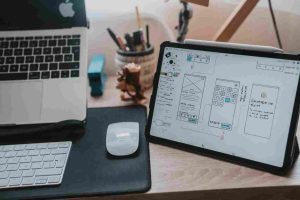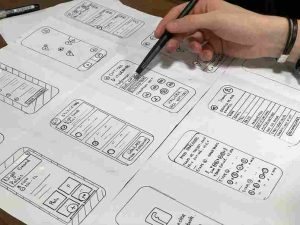The Power Of UX Design In Software Engineering

Jump to Section
Creating exceptional User Experience (UX) is an indispensable aspect of modern software engineering. It involves crafting intuitive interfaces, seamless interactions, and delightful user journeys. By focusing on the end-users’ needs and preferences, UX design aims to enhance usability, satisfaction, and overall product quality. From intuitive navigation to visually appealing interfaces, a well-executed UX design can significantly impact user engagement and retention. In this blog, we explore the crucial role of UX design in software engineering and how it can shape the success of digital products.
The Art Of Empathy: Putting Users At The Center
UX design starts with empathy—the ability to understand and feel the needs, emotions, and motivations of users. By putting users at the centre of the design process, UX designers gain valuable insights that inform their decisions. Platforms like UserTesting.com allow designers to conduct usability testing and gather user feedback. This enables them to understand user preferences, pain points, and expectations. Armed with this knowledge, designers can create software experiences that resonate with users on a deep level.
Example: A UX designer is tasked with redesigning a mobile banking app. They conduct in-depth user research, including interviews and observations, to understand the needs and frustrations of potential users. Through empathy-building exercises, such as creating user personas and empathy maps, they gain a deeper understanding of the target audience’s motivations and pain points. This user-centric approach guides the designer in creating a banking app that prioritises ease of use, security, and personalised features tailored to the users’ financial goals and preferences.
Wireframes And Prototypes: Building The Blueprint
Before bringing a software product to life, UX designers create wireframes and prototypes. Wireframes are basic visual representations that outline the structure and layout of a software interface. Tools like Balsamiq and Sketch facilitate the creation of wireframes, enabling designers to experiment with different design concepts and iterate quickly. Prototypes take wireframes a step further, allowing designers to create interactive and functional models of the software. Tools such as InVision and Adobe XD empower designers to test user flows, interactions, and gather early feedback before development begins.
Example: A UX designer is working on a new e-commerce website. They start by creating wireframes using Balsamiq, experimenting with different layout options, navigation structures, and content placement. They then move on to prototyping the wireframes using InVision, adding interactive elements such as clickable buttons and navigation links. Through user testing, they gather feedback on the prototype’s user flows and identify areas for improvement. This iterative process helps refine the design before development begins, ensuring a seamless and intuitive user experience.
The Power Of Visual Design: Making It Beautiful
Visual design is an essential component of UX design. It encompasses elements like colour, typography, and imagery to create visually appealing software interfaces. Designers utilise tools like Figma and Adobe Creative Cloud to craft stunning visual designs that align with the brand identity and user expectations. Thoughtful use of colour, hierarchy, and visual cues enhances the usability and aesthetic appeal of the software. Visual design ensures that users feel a sense of delight and engagement when interacting with the product, creating a memorable experience.
Example: A UX designer is designing a travel app. They utilise Figma to create visually appealing interface designs that evoke a sense of wanderlust. They carefully select colour palettes that align with the brand’s identity and create a visually cohesive experience. They leverage typography to establish hierarchy and readability, using font sizes and styles that enhance the content’s legibility. By incorporating stunning imagery and thoughtful use of visual elements, they create a visually engaging and memorable travel app that resonates with users.
Seamless Interactions: Navigating With Ease
UX designers focus on creating seamless and intuitive interactions within software interfaces. Navigation plays a crucial role in guiding users through the software. Platforms like Marvel and Framer facilitate the creation of interactive prototypes to test and refine user flows. Designers carefully consider information architecture, menu structures, and navigation patterns to ensure effortless exploration. Through meticulous attention to detail, designers aim to reduce cognitive load and create a sense of flow, allowing users to accomplish tasks effortlessly.
Example: A UX designer is working on a food delivery app. They pay close attention to the app’s navigation, ensuring that users can easily browse menus, add items to their cart, and navigate between screens. They use Marvel to create interactive prototypes, allowing them to test and refine the user flows. Through iterative testing, they fine-tune the app’s navigation patterns, such as the placement of navigation bars, intuitive gestures, and clear calls-to-action. The end result is a food delivery app that offers a seamless and intuitive user experience, making it effortless for users to place orders and track deliveries.
Accessibility: Designing For All
Inclusive design is a core principle of UX design. Software should be accessible to users of all abilities. Designers utilise tools like Color Safe and Stark to ensure sufficient colour contrast for users with visual impairments. They also consider readability, keyboard navigation, and provide alternative text for screen readers. By incorporating accessibility features, designers ensure that software is usable and enjoyable for everyone, regardless of their abilities.
Example: A UX designer is designing a healthcare application. They consider the needs of users with visual impairments by using tools like Color Safe and Stark to ensure sufficient colour contrast for text and important visual elements. They also design with readability in mind, choosing fonts and font sizes that are easily legible for users with varying levels of vision. Additionally, they ensure keyboard accessibility, allowing users to navigate through the app using keyboard commands alone. By incorporating accessibility features, they make the healthcare application inclusive and usable for all users, regardless of their abilities.
Usability Testing: Uncovering The Gems
Usability testing is a crucial phase in UX design. Platforms like UsabilityHub and Optimal Workshop allow designers to conduct usability tests and gather valuable feedback. Through user testing, designers identify pain points, uncover usability issues, and validate design decisions. Iterative testing and user feedback help refine the software, ensuring that it meets user expectations and delivers a delightful experience.
Example: A UX designer is working on a social media platform. They conduct usability tests using platforms like UsabilityHub and Optimal Workshop to gather feedback from users. They observe users as they interact with the platform, noting any difficulties or confusion they encounter. Through this process, they uncover pain points, identify usability issues, and gain valuable insights into user preferences. Based on the feedback received, they make iterative design changes, such as refining the user interface, improving navigation, and enhancing the overall user experience.
Continuous Improvement: Evolving With The Users
UX design is an ongoing process that evolves with user feedback and changing needs. Analytics tools like Google Analytics and Hotjar provide insights into user behaviour and usage patterns. Designers use these insights to identify areas of improvement and make data-driven design decisions. They continuously iterate and refine the software to enhance the user experience, ensuring that it remains relevant and delightful.
Example: A UX designer is involved in the ongoing development of a productivity app. They utilise analytics tools like Google Analytics and Hotjar to gain insights into user behaviour, such as the most frequently used features and the areas where users drop off. By analysing this data, they identify opportunities for improvement and prioritise new features based on user needs and preferences. They then iterate on the app’s design, making data-driven decisions to enhance the user experience and ensure the app remains relevant and valuable to its users.
Level Up Your Ux Design Career With Mentoria’s Guidance And Expertise
In conclusion, User Experience (UX) Design plays a critical role in the field of software engineering, ensuring that products are user-friendly, intuitive, and delightful to interact with. It involves understanding user needs, conducting thorough research, creating intuitive interfaces, and continuously iterating based on feedback. By incorporating UX Design principles into software development, companies can enhance user satisfaction, drive customer loyalty, and gain a competitive edge in the market.
If you’re passionate about UX Design or interested in pursuing a career in software engineering, Mentoria is here to support you. Our experienced mentors can provide guidance, resources, and practical advice to help you develop your skills, build a strong portfolio, and navigate the exciting world of UX Design. Don’t miss out on the opportunity to accelerate your career with Mentoria.









